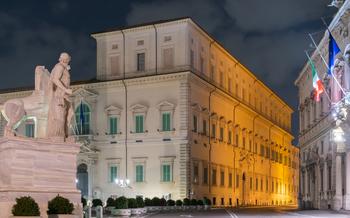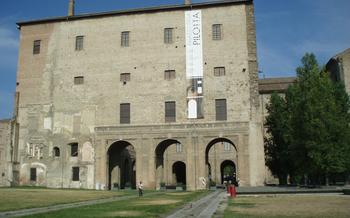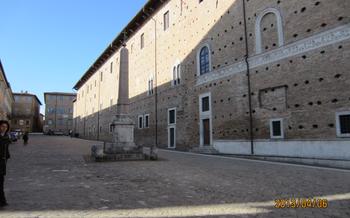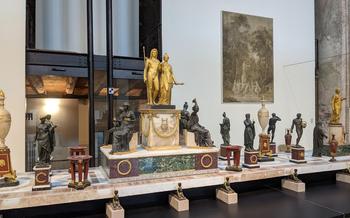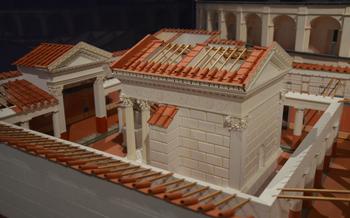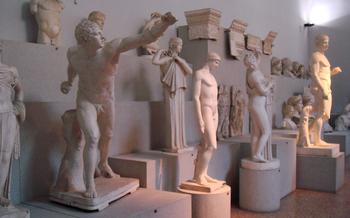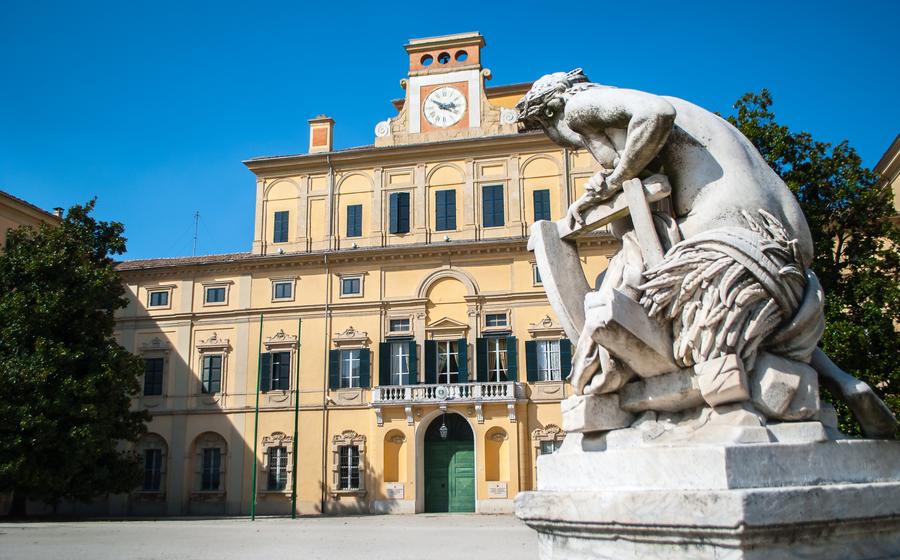
Palazzo Ducale di Parma
- Introduction
- History and Origins
- Architectural Highlights
- The Courtyard and Statues
- The Grand Staircase: A Testament to Grandeur and Opulence
- The Ducal Apartments
- The Throne Room
- The Picture Gallery
- The National Archaeological Museum
- The Ducal Gardens
- Temporary Exhibitions
- Cultural Events
- Guided Tours
- Practical Information
- Insider Tip: Unveiling the Palazzo Ducale's Enchanting Secrets
Introduction
The Palazzo Ducale di Parma, a magnificent architectural masterpiece, stands as a testament to the city's rich history, cultural heritage, and enduring power. With its imposing façade, Renaissance-inspired design, and intricate ornamentation, the palace embodies the grandeur and prestige of Parma's ruling families. Once the residence of the dukes of Parma and Piacenza, it served as the political, administrative, and cultural center of the city for centuries, leaving an indelible mark on Parma's identity.
The construction of the Palazzo Ducale began in the 16th century under the patronage of the Farnese family, who ruled Parma and Piacenza for over two centuries. The palace's grand scale and lavish embellishments reflect the family's wealth and influence, as well as their desire to create a monumental symbol of their power and prestige. The palace's subsequent expansions and renovations further enhanced its grandeur, making it a true architectural masterpiece that continues to captivate visitors to this day.
History and Origins
The construction of the Palazzo Ducale di Parma, commissioned by the Farnese family, began in 1561 and spanned several decades. The palace was designed as a symbol of the family's power and influence, and primarily served as a residence for the dukes of Parma and Piacenza. The project saw various stages of construction and expansion throughout the years, reflecting the evolving needs and aspirations of the Farnese dynasty.
The palace underwent significant transformations under the rule of Duke Odoardo Farnese, who engaged renowned architect Francesco Paciotto to expand and enhance the original structure. Paciotto's contributions included the addition of the majestic façade and the grand courtyard, creating an awe-inspiring and harmonious ensemble. Subsequent dukes contributed to the palace's grandeur, leaving their mark through architectural modifications and artistic embellishments.
The Palazzo Ducale di Parma has been witness to numerous historical events that shaped the city's destiny. It served as a political hub where alliances were forged, decisions were made, and guests of honor were received with opulent ceremonies. The palace hosted lavish banquets, theatrical performances, and gatherings that celebrated the cultural and artistic achievements of the ducal court.
Architectural Highlights
The Palazzo Ducale di Parma stands out for its remarkable architectural features, embodying the grandeur and elegance of the Renaissance style. Its majestic façade, adorned with intricate carvings and imposing columns, creates an awe-inspiring first impression. Symmetry and proportionality are evident throughout the structure, reflecting the classical ideals of balance and harmony that characterized Renaissance architecture.
The palace's decorative elements and sculptures further enhance its visual appeal. Exquisite bas-reliefs, cornices, and pediments adorn the façade, narrating stories from mythology and history. Statues of mythological figures and allegorical representations stand sentinel at strategic points, adding a touch of grandeur and symbolism to the overall design.
The Palazzo Ducale's architectural highlights are a testament to the skill and artistry of the Renaissance masters who conceived and constructed this magnificent edifice. Its harmonious proportions, intricate ornamentation, and symbolic sculptures make it a masterpiece of Italian Renaissance architecture and a must-see for anyone interested in art, history, and culture.
The Courtyard and Statues
The central courtyard of the Palazzo Ducale di Parma is a sight to behold. A grand fountain takes center stage, surrounded by a mesmerizing array of statues depicting mythological figures and allegorical representations. Each statue is a masterpiece of artistry, intricately carved from Carrara marble and brought to life by skilled craftsmen.
These statues are not mere decorative elements; they hold deep symbolic meanings and serve as a testament to the cultural and political significance of the palace. They represent virtues, ideals, and historical events that shaped the identity of Parma and its ruling family.
Among the notable statues, one can find Hercules slaying the Hydra, a powerful symbol of strength and victory. There's also Minerva, the goddess of wisdom and warfare, representing the intellectual and military prowess of the Farnese family. Other statues depict allegorical figures such as Justice, Abundance, and Peace, reflecting the values that the dukes aspired to uphold.
The creation of these statues involved a collaboration of talented artists and craftsmen. Renowned sculptors like Gian Battista Trotti, known as il Malosso, and Prospero Clementi left their indelible mark on the palace's courtyard. Their attention to detail, mastery of anatomy, and ability to capture emotional expressions bring these statues to life, creating a captivating spectacle for visitors to admire.
The Grand Staircase: A Testament to Grandeur and Opulence
Ascending from the elegant courtyard, visitors are greeted by the awe-inspiring Grand Staircase, a masterpiece of architectural design. This monumental staircase, adorned with intricate frescoes and marble balustrades, leads to the upper floors of the Palazzo Ducale, symbolizing the palace's grandeur and opulence.
The walls of the staircase are adorned with elaborate frescoes, each telling a different story from the history of Parma and the Farnese family. These frescoes, painted by renowned artists of the time, depict scenes of battles, triumphs, and mythological tales, adding to the rich narrative of the palace.
The marble balustrades lining the staircase are exquisitely carved with intricate designs, demonstrating the exceptional craftsmanship that went into every detail of the Palazzo Ducale. The balustrades, with their graceful curves and delicate ornamentation, lend an air of refinement and elegance to the grand staircase.
As visitors ascend the Grand Staircase, they are enveloped in a sense of awe and wonder. The combination of the elaborate frescoes, the opulent marble balustrades, and the sheer scale of the staircase creates an unforgettable experience, leaving a lasting impression on all who behold it.
The Ducal Apartments
The Ducal Apartments were the private living quarters of the dukes of Parma and Piacenza and their families. These opulent chambers, located on the upper floors of the palace, offer a glimpse into the lavish lifestyle and history of the Farnese dynasty. Visitors can wander through grand halls adorned with intricate frescoes, crystal chandeliers, and antique tapestries, immersing themselves in the atmosphere of a bygone era.
Each room has its own unique story to tell. The Sala del Trono, or Throne Room, was used for official functions and ceremonies, while the Sala degli Specchi, or Hall of Mirrors, was a favorite gathering place for the dukes and their guests. The Sala da Pranzo, or Dining Room, boasts a magnificent ceiling fresco depicting mythological scenes, and the Camera da Letto, or Bedroom, offers a more intimate glimpse into the private life of the dukes.
The Ducal Apartments are not only a testament to the wealth and power of the Farnese family but also a showcase of the finest craftsmanship and artistry of the 16th and 17th centuries. Visitors can admire the exquisite furniture, paintings, and sculptures that adorn these grand spaces, each piece contributing to the overall splendor and opulence of the palace.
The Throne Room
The Throne Room, also known as the Sala del Trono, is the grandest and most impressive room in the Palazzo Ducale, designed to reflect the power and authority of the dukes of Parma and Piacenza. Its ceiling is adorned with elaborate frescoes depicting mythological scenes and allegorical representations, symbolizing the virtues and achievements of the Farnese family. The walls are adorned with tapestries and paintings that celebrate the history and lineage of the dukes.
The throne itself is a magnificent work of art, carved from precious materials and intricately decorated with gold leaf and jewels. It is placed on a raised platform, emphasizing the duke's elevated status. The Throne Room was used for official functions and receptions, where the dukes would receive foreign dignitaries, hold court, and make important announcements. It was also the setting for lavish banquets, balls, and other grand celebrations.
One of the most notable historical events that took place in the Throne Room was the wedding of Alessandro Farnese, Duke of Parma, to Princess Maria of Portugal in 156The marriage was a significant political alliance between the Farnese and Portuguese royal families and was celebrated with great splendor in the palace. The Throne Room has witnessed many other important events throughout history, serving as a testament to the power and prestige of the dukes of Parma and Piacenza.
The Picture Gallery
The Palazzo Ducale di Parma also houses an impressive art collection, known as the Galleria Nazionale di Parma. With over 4,000 works spanning various artistic periods, the gallery is a must-visit for art enthusiasts.
Among the highlights of the collection are masterpieces from the Renaissance to the 19th century, with a strong focus on local artists. Visitors can admire breathtaking works by Correggio, Parmigianino, the Carracci brothers, and many more.
The gallery is thematically organized, allowing visitors to explore different genres, styles, and movements. From religious art to portraits, from landscapes to still lifes, the collection offers a diverse range of artistic expressions.
The curatorial approach of the gallery emphasizes the historical and cultural context of the works, providing insights into the artistic production and cultural significance of each period.
Temporary exhibitions are occasionally held in the gallery, showcasing specific artists, themes, or collaborations with prestigious institutions from around the world. These exhibitions offer visitors the opportunity to experience a variety of artistic expressions and perspectives, enriching their exploration of the gallery's permanent collection.
The National Archaeological Museum
Housed within the grand walls of the Palazzo Ducale, the National Archaeological Museum of Parma is a treasure trove of ancient artifacts that narrates the rich history of the region and beyond. Its extensive collection spans various civilizations, offering a glimpse into the lives and cultures of our ancestors.
Among the highlights of the museum are the Roman antiquities, which include well-preserved mosaics, sculptures, and pottery. These artifacts provide insights into the daily life, art, and religious practices of the Romans who once inhabited the region.
The Etruscan collection is another highlight, showcasing artifacts from this ancient civilization that flourished in central Italy. Visitors can admire intricate gold jewelry, bronze sculptures, and ceramic vessels that reveal the Etruscan's mastery of craftsmanship and artistic expression.
The museum also houses a significant collection of Egyptian antiquities, including mummies, amulets, and funerary objects. These artifacts offer a glimpse into the ancient Egyptian beliefs and practices surrounding death and the afterlife.
Through its diverse collection, the National Archaeological Museum provides a fascinating journey through the history and cultures of ancient civilizations. It is a must-visit for anyone interested in exploring the region's rich heritage and gaining a deeper understanding of our shared human past.
The Ducal Gardens
The Palazzo Ducale is surrounded by a magnificent garden, known as the Ducal Gardens. Designed in the Italian Renaissance style, the gardens are a testament to the palace's opulence and grandeur. Visitors can stroll through the beautifully manicured lawns, admire the elegant fountains and sculptures, and immerse themselves in the serene atmosphere.
The gardens were initially conceived by the Farnese family in the 16th century as a private retreat for the dukes and their guests. Over the years, the gardens underwent several expansions and modifications, eventually reaching their current size and design. The gardens were laid out in a symmetrical pattern, with central pathways radiating from a central fountain. The pathways are lined with hedges, trees, and flower beds, creating a sense of order and harmony.
The Ducal Gardens are adorned with a variety of sculptures, both ancient and modern. Statues of mythological figures, allegorical representations, and other decorative elements grace the gardens, adding to their charm and beauty. The gardens also feature several fountains, providing a refreshing and tranquil ambiance. The largest fountain is the central fountain, which is located at the intersection of the main pathways. The fountain is decorated with intricate carvings and sculptures, making it a focal point of the gardens.
Today, the Ducal Gardens are a popular spot for locals and visitors alike to relax and enjoy the outdoors. They provide a tranquil oasis in the heart of Parma, where visitors can escape the hustle and bustle of the city and immerse themselves in the beauty of nature.
Temporary Exhibitions
The Palazzo Ducale is not only a historical and architectural treasure but also a vibrant cultural hub that hosts a variety of temporary exhibitions throughout the year. These exhibitions cover a wide range of themes, from art and history to photography and contemporary issues. The palace collaborates with prestigious institutions worldwide to bring visitors a diverse range of cultural experiences.
Temporary exhibitions at the Palazzo Ducale offer visitors an opportunity to explore new perspectives, discover emerging artists, and delve into different historical periods and artistic movements. The exhibitions are often curated by experts in their respective fields, ensuring a high level of quality and authenticity. They also provide a platform for cultural exchange and dialogue, fostering a deeper understanding and appreciation of diverse cultures and viewpoints.
Whether you are an art enthusiast, a history buff, or simply curious to learn something new, the temporary exhibitions at the Palazzo Ducale are sure to offer a rewarding and enriching experience. Be sure to check the palace's website or social media channels for upcoming exhibitions and events to plan your visit accordingly.
Cultural Events
The Palazzo Ducale is not just a historical monument but also a vibrant cultural hub. Throughout the year, it hosts a variety of cultural events that bring the palace to life and offer visitors unique experiences. Collaborating with local and international artists, the palace presents concerts, conferences, and performances that showcase diverse talents and perspectives.
Music enthusiasts can enjoy concerts ranging from classical to contemporary, while art lovers can attend exhibitions featuring emerging and established artists. The palace's grand halls and elegant courtyards provide a stunning backdrop for these events, creating a memorable and immersive experience.
Beyond the arts, the Palazzo Ducale also hosts conferences and lectures on history, archaeology, and other cultural themes. These events bring together experts and enthusiasts to share knowledge, engage in discussions, and foster intellectual exchange.
By attending these cultural events, visitors not only get to experience the beauty and grandeur of the Palazzo Ducale but also become part of a vibrant community that celebrates creativity, knowledge, and cultural diversity.
Guided Tours
The Palazzo Ducale offers guided tours to enhance the visitor experience and provide insights into the palace's rich history, art, and cultural significance. Led by knowledgeable and passionate guides, these tours take visitors through the palace's highlights, including the grand courtyard, the monumental staircase, the ducal apartments, the throne room, and the picture gallery. The guides share captivating stories, anecdotes, and historical information, bringing the palace's past to life.
Reservations for guided tours can be made in advance to secure a spot and avoid disappointment. Tours are available in various languages to accommodate international visitors. For a more personalized experience, private tours can be arranged upon request.
Whether you're an art enthusiast, a history buff, or simply someone who appreciates architectural beauty, a guided tour of the Palazzo Ducale is an enriching and memorable experience. Take advantage of this opportunity to delve deeper into the palace's treasures and gain a profound understanding of its cultural and historical significance.
Practical Information
The Palazzo Ducale di Parma is conveniently located in the heart of Parma, at Piazza Duomo, To get there, you can take a short walk from the city's main train station or use public transportation. The palace is open to the public from Tuesday to Sunday, with guided tours available in multiple languages.
Admission fees vary depending on the type of ticket, with discounts offered for students, seniors, and families. Visitors with disabilities are provided with wheelchair access and assisted tours upon request. The palace also features facilities such as a bookshop, a café, and restrooms for visitors' convenience.
To make the most of your visit, consider joining a guided tour led by knowledgeable and passionate guides. These tours offer insights into the history, art, and cultural significance of the palace, bringing its stories and secrets to life. Reservations for guided tours can be made online or through the palace's information desk.
Insider Tip: Unveiling the Palazzo Ducale's Enchanting Secrets
To truly savor the essence of the Palazzo Ducale and immerse yourself in its rich history, consider planning your visit during the off-season, which runs from October to April. During this period, the palace exudes a serene and intimate atmosphere, free from the throngs of tourists that often crowd its halls during peak season. This serene ambiance allows you to fully appreciate the intricate details of the palace's architecture, art, and exhibits without feeling rushed or overwhelmed.
Strolling through the grand halls and chambers, you'll have ample time to ponder the stories and secrets that these walls hold. Imagine the lavish banquets and courtly ceremonies that once took place within these opulent surroundings. Take your time to admire the exquisite frescoes, tapestries, and sculptures, each a testament to the artistic mastery of the Renaissance era.
The off-season also presents an excellent opportunity to engage with the knowledgeable guides who lead the palace tours. With fewer visitors to attend to, they can offer a more personalized and in-depth experience, sharing captivating tales and anecdotes that bring the palace's history to life.
So, if you seek an unforgettable encounter with the Palazzo Ducale, embrace the tranquility of the off-season and prepare to be mesmerized by its timeless elegance and hidden treasures.



